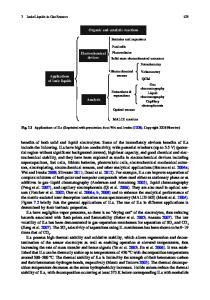Metal Oxide-Based Nanocomposites for Conductometric Gas Sensors
Metal-metal oxide and metal oxide-metal oxide composites are discussed in present chapter. It is shown that due to the addition in metal oxide matrix either noble metal nanoparticles or second metal oxides, important for gas sensor applications highly sop
- PDF / 434,572 Bytes
- 11 Pages / 504.57 x 720 pts Page_size
- 94 Downloads / 309 Views
Metal Oxide-Based Nanocomposites for Conductometric Gas Sensors
14.1
Metal–Metal Oxide Composites
In principle, almost all metal oxide gas sensors can be considered as composite-based sensors because they usually consist of noble metal nanoparticles incorporated in a metal oxide gas-sensing matrix. The metal nanoparticles play both passive and active roles in the sensing process (Kohl 1990; Korotcenkov 2005, 2010; Korotcenkov and Sysoev 2011; Yang 2011). First, metal nanoparticles such as platinum (Pt), palladium (Pd), gold (Au), and silver (Ag) show catalytic properties that can modify the analyte–metal oxide chemical interactions, increase catalytic activity, and enhance the sensing process. Metallic nanoparticles, presented on the surface of metal oxide, activate or dissociate the detected gas. As a result, these activated products are easier to react with the adsorbed oxygen species on the metal oxide surface, resulting in a change of the resistance. Second, the interfacial region between metal nanoparticles and metal oxide also has a very different electron band structure from than inside the bulk semiconducting metal oxide, which also contributes to the unique gas-sensing properties of this type of nanocomposite. Direct exchange of electrons between the semiconductor metal oxide and metallic nanoparticles causes a change in the width of the depletion layer of the semiconductor oxide, leading to a change in sensing properties. It was established that metal nanoparticles embedded in a metal oxide matrix can reduce the sensing temperatures, improve the selectivity, decrease response and recovery times, and increase the response of sensors (Korotcenkov et al. 2003; Korotcenkov 2005, 2010). In addition, metal nanoparticle can reduce the electrical resistance and increase the optical absorption of metal oxide. One can find in Chap. 10 (Vol. 1) a more detailed description of the role of metal nanoparticles in gas-sensing effects. However, despite a number of long-term efforts to quantify the effect of the foreign metal phase on the gas-sensing properties of the MOXs, there is still a need to understand better the underlying fundamental mechanisms, because the effect of each additive in the metal oxide matrix is complex and, till now, has not been well studied. Thorough characterization of even such simple systems as stable metal clusters on the oxides requires experimental data on the cluster sizes, their surface orientation, deficiency, mobility, etc. For preparing metal–metal oxide composites, various methods can be used. For example, using ceramic and thick-film technologies, noble metal catalysts can be incorporated into a MOX by: (1) impregnating the pristine MOX powder with a noble metal chloride such as PtCl4 and PdCl2 solution, followed by drying and calcination (Matsushima et al. 1992); (2) mixing the pristine MOX powder with a colloid of noble metal (Nakao 1995); and (3) chemical bonding of noble metal complexes such as PdCl42− with surface hydroxyls at the pristine MOX in solution (Kaji et al. 1980). T
Data Loading...











